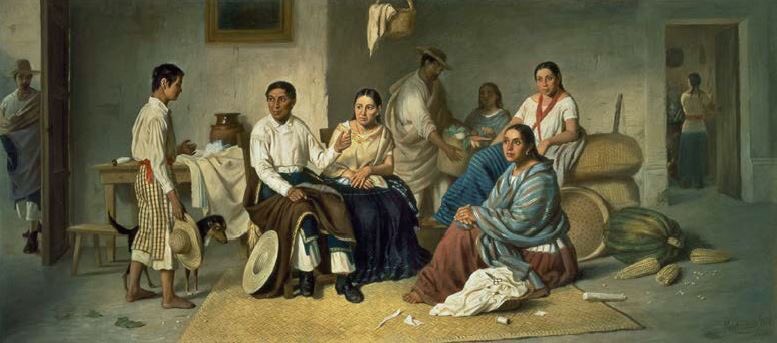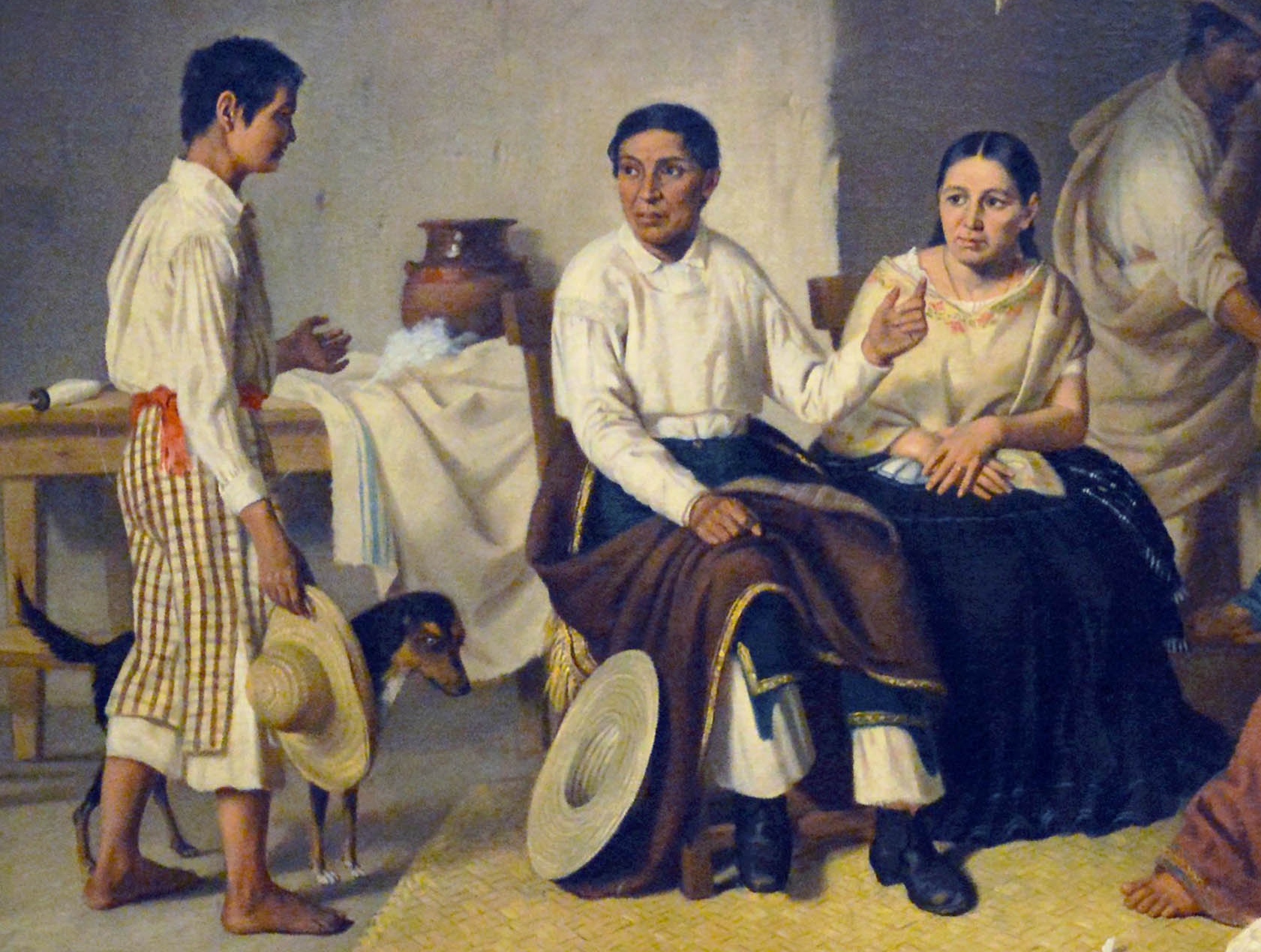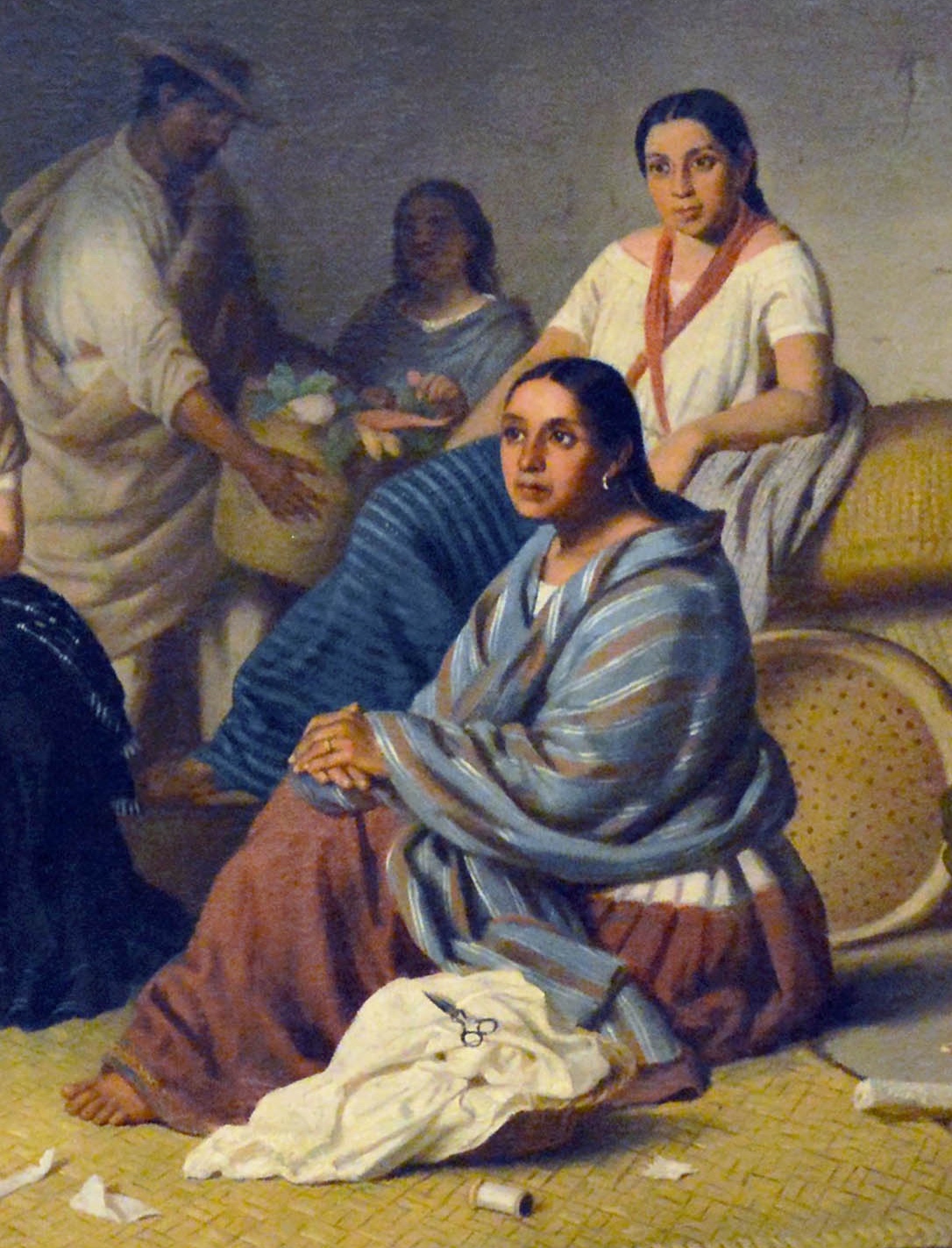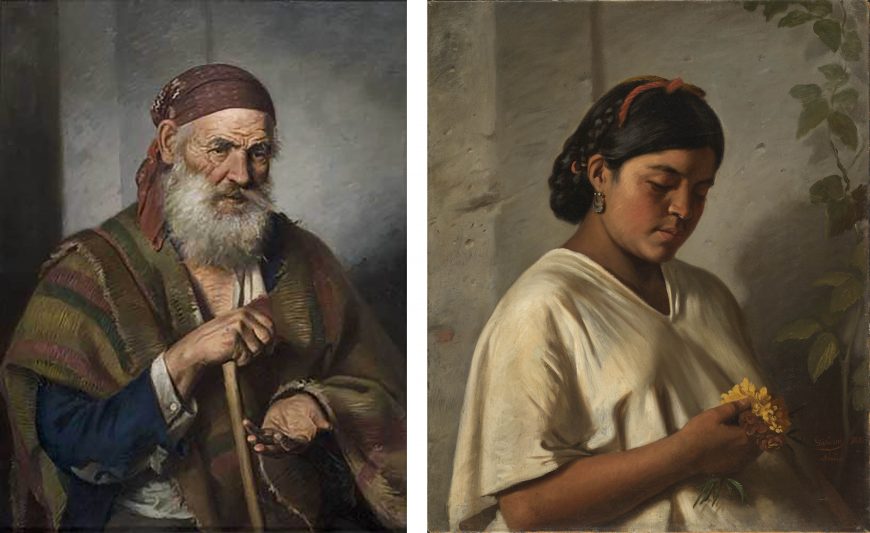
Felipe Santiago Gutiérrez, La despedida del joven indio (The Young Indian’s Farewell), 1876, oil on canvas, 82 x 92 cm (Private Collection, Mexico City)
Saying goodbye
Who are the figures gathered in this simple abode? What are they discussing so intently? Where do the doorways on either side of the central scene lead to?
These are just a few of the questions that this composition of everyday Mexican life invites. In La despedida del joven indio (The Young Indian’s Farewell), Felipe Santiago Gutiérrez, one of Mexico’s most versatile and notable nineteenth-century painters, represents a coming of age scene — one with a political and national message. As implied by the title of the painting, a young Amerindian boy who approaches from the left has come to say goodbye to his family, presumably leaving his country life in search of education and a career in the city.
Depictions of everyday life
Felipe Santiago Gutiérrez’s La despedida is an example of a costumbrista painting. Costumbrismo, a genre of art and literature in Spain and Latin America, sought to portray local customs and traditions from everyday life, and was popular in the nineteenth century. Gutiérrez was a well-traveled, academically trained artist, who wrote about art exhibitions in prominent journals and even wrote his own artistic treatise, one of the first of its kind by a Mexican artist. He actively produced history paintings and portraits in the prevailing neoclassical style of the academy (El juramento de Bruto, 1857), also producing the first female nude in Mexican art (La cazadora de los Andes, c. 1874). However, it was Costumbrismo that he championed, painting everyday subjects, and advocating for this genre in his many writings.

Detail, Felipe Santiago Gutiérrez, La despedida del joven indio (The Young Indian’s Farewell), 1876, oil on canvas, 82 x 92 cm (Private Collection, Mexico City)

Detail, Felipe Santiago Gutiérrez, La despedida del joven indio (The Young Indian’s Farewell), 1876, oil on canvas, 82 x 92 cm (Private Collection, Mexico City)
In La despedida del joven indio, Gutiérrez presents the interior of a simple, peasant home. Centrally placed in the composition is a family, perhaps the mother, father and sister of the young Amerindian boy who comes to bid farewell. The boy is barefoot and holds his hat in his right hand while he speaks. His left hand gestures forward as he respectfully addresses his family.
The clean-cut figures are dressed in traditional clothing: rebozos (shawls) and long skirts for the women and a white shirt, wide-legged pants, and a manto (cloak) for the man. Strategically placed objects serve at once to decorate the living space, as well as reference the family’s cultural roots. On the right-hand side, there is a large calabaza (pumpkin) and ears of corn; on the left side, along the wall, there is a table strewn with pottery and textiles. A basket hangs centrally, holding a tablecloth.
Doorways on either side of the family create perspective and add complexity to the interior space. Other family members or friends enter and exit. The doorways that suggest spaces beyond the main room recall seventeenth-century Dutch genre paintings, which use similar compositional strategies to expand interior spaces as well create a bit of intrigue. Having been trained in the academy and exposed to Flemish and Dutch prints, Gutiérrez demonstrates his familiarity with European artistic traditions.
Art and national identity
La despedida was commissioned by Felipe Sánchez Solís, an Amerindian of humble roots who became a prominent intellectual and political figure in the nineteenth century. Like the figure in the painting, Sánchez Solís left his small village for Mexico City in order to study literature and law, eventually becoming director of the Scientific and Literary Institute of Toluca. Gutiérrez’s painting is therefore both personal and political. The painting refers to Sánchez Solís’s own story as a young boy leaving his family in order to pursue his education and secure his place among Mexico’s intellectual literary elite. This places value on Mexico’s Indigenous past while also suggesting an idealized path toward integrating Indigenous people in service of the nation. Like Gutiérrez, Sánchez Solís was a patron of the arts and of the academy, and he believed in the importance of the arts in establishing a national identity.
Gutiérrez sought to create art that would change the perception and status of the artist in Mexico, and he wrote about the alliance between artistic culture and nationalistic discourse. Gutiérrez wanted the world—specifically Europe—to know Mexico’s customs, cities, and natural beauty. He believed this would alter Europe’s perception of Mexico as a barbarous, uncivilized nation.
In his treatise, Tratado del Dibujo y la Pintura (Treatise of Drawing and Painting, 1895), Gutiérrez praised the artist of genre paintings,
The genre painter’s scenes are temples, public plazas, the streets and the countryside. His paintings of a fruit vendor, a florist, a group of proud boys that ridicule a drunkard or a blind man who goes door to door, covered in rags, asking for sustenance are lively and poetic. When translated to canvas with the magic of his brush, they cause admiration among his contemporaries and he is glorified for posterity. Felipe Santiago Gutiérrez, Tratado del Dibujo y la Pintura, con un apéndice de los diversos carácteres de las escuelas antigua y moderna (Mexico City: Fondo regional para la cultura y las artes. Zona centro, 1895)
Costumbrista paintings depicted genre scenes particular to Mexican life, aiding in the construction of a Mexican national identity. In Costumbrista paintings like El mendigo (The Beggar) and Mujer indígena con cempasúchil (Indigenous Woman with Marigold), Gutiérrez visualizes his written words. In El mendigo, Gutiérrez depicts a beggar with a majestic presence.

Left: Felipe Santiago Gutiérrez, El mendigo (The Beggar), c. 1891, oil on canvas, 86 x 65.5 cm (Museo Nacional de Colombia); right: Mujer indígena con cempasúchil (Indigenous Woman with Marigold), 1876, oil on canvas, 68 x 56.5 cm (Los Angeles County Museum of Art).
Every wrinkle in the beggar’s kind face is visible. His worn, striped sarape draped over his white cuffed shirt and blue blazer seem to refer to a more affluent past. In Mujer indígena con cempasúchil, Gutiérrez portrays an Indigenous, pregnant mother wearing a huipil (a traditional, loose-fitting blouse) contemplating a marigold. The marigold, a flower the Aztecs associated with mortality, was believed to guide the spirits of the dead to the living, and is the traditional flower laid on graves and altars during el Día de los Muertos (Day of the Dead) celebrations. The expecting mother reflects on the fragility of life.
As an academic artist concerned with promoting classical aesthetics and elevating the status of the Mexican artist, Gutiérrez vocalized his conviction that the cultivation of the arts in Mexico and the recognition of the talent of Mexican artists would enable Mexico to achieve the status it deserved. Through his embrace of contemporary subjects and Costumbrismo, Gutiérrez revealed his desire for change and his interest in modernizing his nation, looking to Europe as a model. Gutiérrez’s costumbrista works would find resonance in the art of twentieth-century Mexican modernists like Saturnino Herrán, Diego Rivera, Alfredo Ramos Martínez, Frida Kahlo, and many others, who sought to represent local customs and traditions as symbols of Mexicanidad in the wake of the Mexican Revolution.
Additional resources

